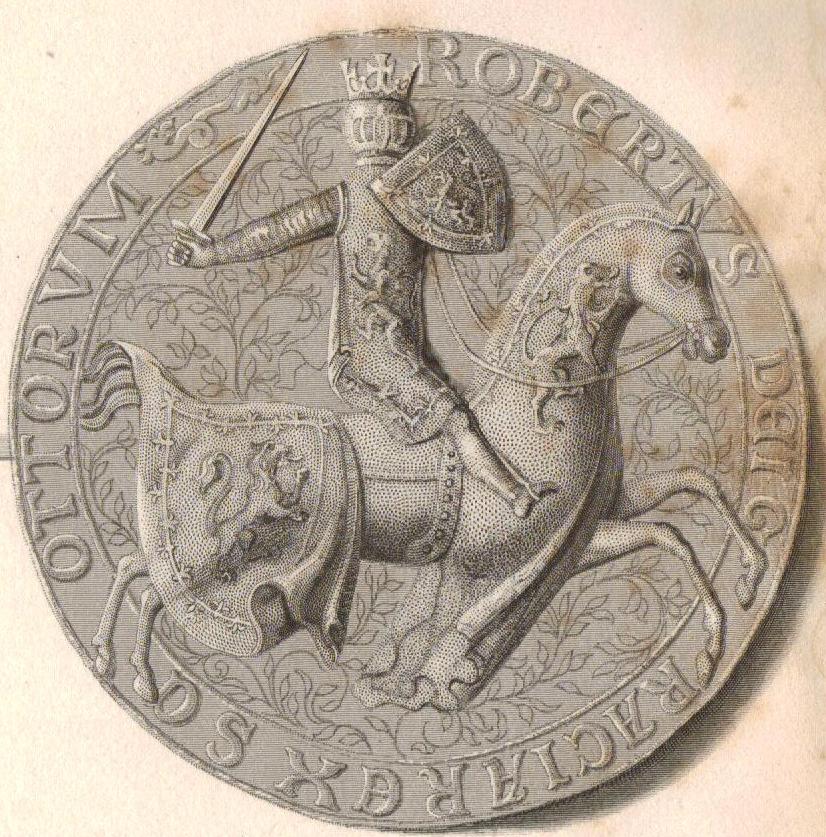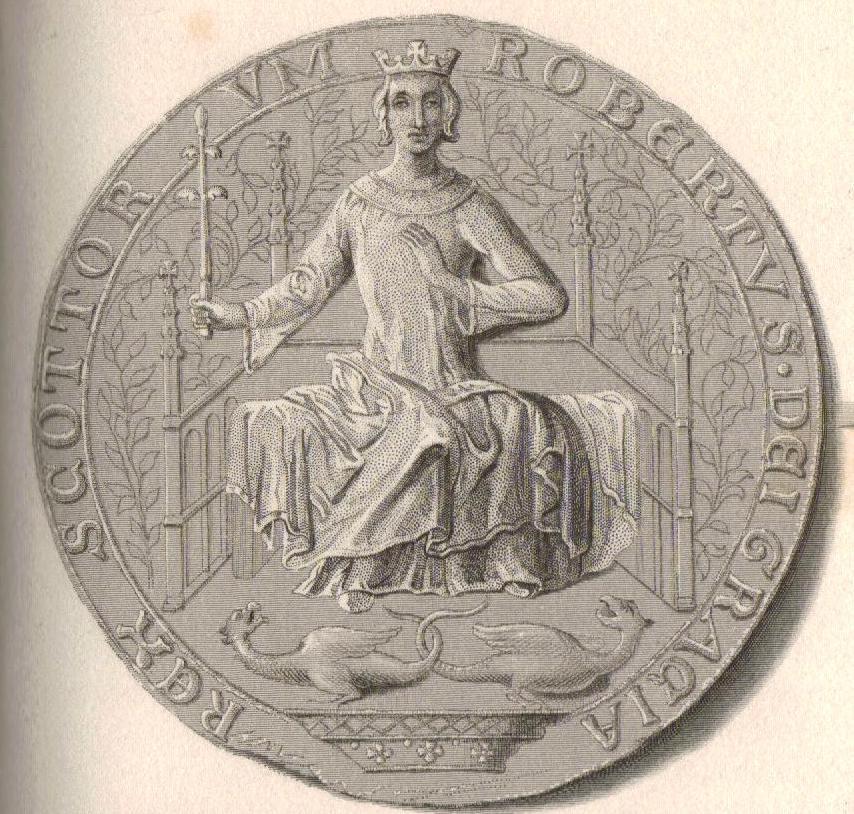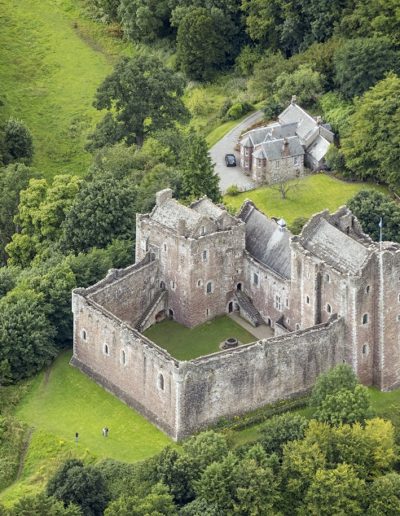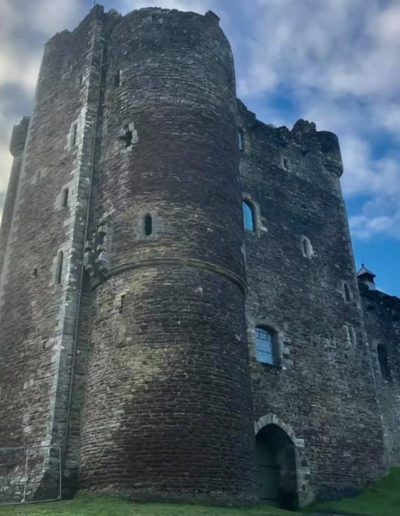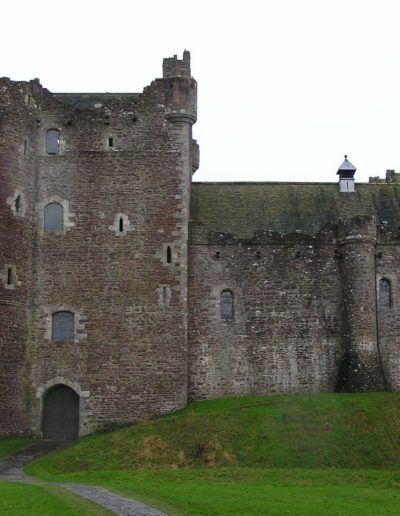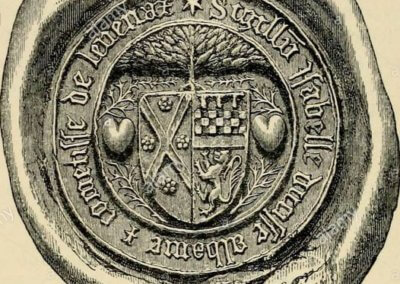The Stewarts of Albany
The events that gave rise to what later became the Stewarts of Balquhidder began with the family of the Stewarts of Albany — a royal family caught up in the power struggles of their era with stories of alleged murder, betrayal and rebellion. Without these events, the Stewarts of Balquhidder would never have come into existence. In fact, they may have been kings!
In the late 14th century, Robert Stewart, Duke of Albany, younger son of King Robert II, was one of the most powerful men in Scotland, and he was third in line to the throne after the king’s two surviving sons, David Stewart, Duke of Rothesay, and Prince James Stewart. It has been traditionally suggested that he sought the crown for himself and had his rival and nephew, David Stewart, Duke of Rothesay, murdered. The king, fearing for the life of his only remaining son, young Prince James, had James sent to France for safety. However, James’ ship was intercepted by the English and James spent the next 18 years in captivity in England.
During Prince James’ captivity, his father died, and James became the uncrowned King of Scots. Meanwhile, Robert Stewart, Duke of Albany, ruled Scotland in the king’s absence and did little to help secure the release of young King James. Upon Robert’s death, his son, Murdoch Stewart became 2nd Duke of Albany. He, too, did little to secure the king’s release and ruled in place of the king.
When King James I was finally released and returned home, he perceived the Albany family to be a threat to his crown. He had the Albany Stewarts arrested and executed. All except one: Sir James Mhor Stewart of Albany, son of Murdoch Stewart, 2nd Duke of Albany, escaped the king’s vengeance and fled to Ireland, but not before burning the town of Dumbarton and killing the governor. James Mhor Stewart lived out the rest of his short life in exile in Ireland. His son, James Beag Stewart, later returned home to Scotland thanks to his grandmother, where his descendants became the Stewarts of Balquhidder.
At least that’s the traditional version of the story. The truth is not quite so simple as you’ll see below.
Doune Castle
Primary residence of the Stewart Dukes of Albany.
c/o Historic Environment Scotland
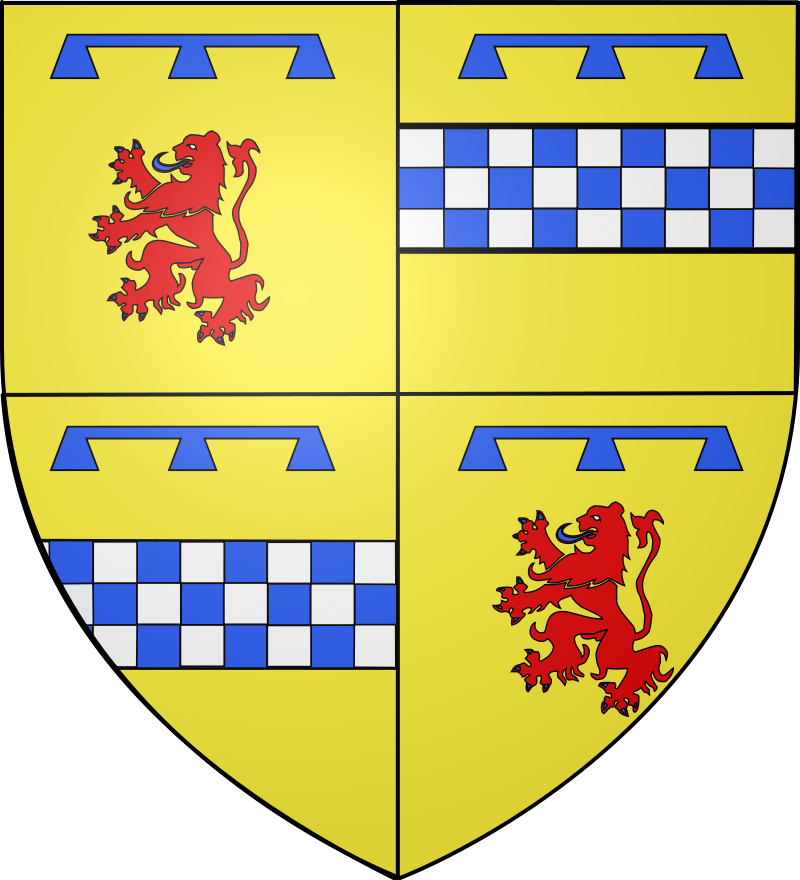
The Arms of Robert Stewart, 1st Duke of Albany.
(These arms are used in the logo of this site.)
The earlier origins of the Stewarts before they became royal can be found by clicking the button below:
Sources
In our research, we cite many documentary sources. Some of the most common ones that you will find referenced and abbreviated in our notes include:
- Duncan Stewart (1739). A Short Historical and Genealogical Account of the Surname Stewart…. (It’s actual title is much longer), by Rev. Duncan Stewart, M.A., 1st of Strathgarry and Innerhadden, son of Donald Stewart, 5th of Invernahyle, published in 1739. Public domain.
- Stewarts of the South. A large collection of letters written circa 1818-1820 by Capt. James Stewart, factor (estate manager) to Maj. Gen. David Stewart of Garth, comprising a near complete inventory of all Stewart families living in southern Perthshire, including all branches of the Stewarts of Balquhidder.
- MacGregor, Gordon, The Red Book of Scotland. 2020 (http://redbookofscotland.co.uk/, used with permission). Gordon MacGregor is one of Scotland’s premier professional family history researchers who has conducted commissioned research on behalf of the Lord Lyon Court. He has produced a nine volume encyclopedic collection of the genealogies of all of Scotland’s landed families with meticulous primary source references. Gordon has worked privately with our research team for over 20 years.
- [Parish Name] OPR. This refers to various Old Parish Registers.
- For a full list of sources, click here.
The Royal Stewarts
Robert Stewart, King Robert II of Scots
Robert Stewart, King Robert II of Scots, b. 2 Mar 1316, Paisley, Renfrewshire, Scotland ![]() , d. 14 Aug 1390, Castle Dundonald, Ayrshire, Scotland,
, d. 14 Aug 1390, Castle Dundonald, Ayrshire, Scotland, ![]() as the only son of Walter Stewart, 6th High Steward of Scotland and Princess Marjorie Bruce, daughter of King Robert the Bruce.
as the only son of Walter Stewart, 6th High Steward of Scotland and Princess Marjorie Bruce, daughter of King Robert the Bruce.
The Stewarts rose to prominence in Scotland as the hereditary High Stewards of Scotland. This office was effectively the business manager for the country, one of the most powerful offices in the country and one of the closest to the king.
During the Wars of Independence, Robert The Bruce claimed the Crown and fought endlessly for the liberty of Scotland. He became venerated as the Hero King of Scotland. After his victory at the Battle of Bannockburn, Robert The Bruce rewarded his loyal knights in any way he could. To his loyal knight and friend, Walter Stewart, the 6th Hereditary High Steward of Scotland, he contracted marriage with his eldest daughter, Marjorie Bruce.
Birth
Marjorie became pregnant and on 2 March 1316 she was out riding her horse on the Stewart lands near Paisley Abbey when she fell from her horse and was killed. At this time, King Robert The Bruce still had no male heir to the throne which meant that if Marjorie’s unborn child was a boy then he would be first in line for the throne. Marjorie’s lifeless body was rushed to nearby Paisley Abbey where an emergency Caesarian section was performed and her son, Robert Stewart, was born heir presumptive to the throne of Scotland. He was named after his heroic grandfather, Robert The Bruce.
Heir to the Throne
When Robert was 8-years-old his maternal grandparents gave birth to a son, David, who became heir apparent and Robert became second-in-line for the throne. At age 11, Robert’s father died and Robert inherited the office of High Steward of Scotland and became Earl of Strathearn. When Robert The Bruce died, his 5-year-old son became King David II of Scots and Robert Stewart, young Earl of Strathearn, was again heir presumptive.
Between 1334-1357, amidst further aggression from England, King David was forced to flee to France for safety and was later captured by the English. During much of the King’s absences Robert Stewart jointly ruled Scotland on behalf of the King.
Fathering a Dynasty
Meanwhile, Robert Stewart was busy fathering as many children as humanly possible with two wives and several mistresses. He recognized that effective wielding of ruling power in his day required alliances of family and marriage. Dr. Shayna Devlin, PhD (University of Guelph, 2019) refers to this as the “corporate” nature of medieval rulership — that effective rulers ruled through their family connections, not merely through personal power and charisma. Robert Stewart fathered about two dozen known legitimate and illegitimate children and ensured that as many as possible were either elevated to positions of power or married to those with power. At the zenith of his power, 8 of Scotland’s 15 earldoms were in the possession of either Robert Stewart’s sons or sons-in-law.
There was a small problem with Robert’s nepotistic power base that would haunt this family and all of Scotland for generations. Robert’s first marriage to Elizabeth Mure of Rowallan was declared “non-canonical” (not recognized by the Roman Catholic Church). Robert recognized the threat this posed to his power base and in 1347, with papal dispensation, he and Elizabeth married a second time in, this time in the Roman Catholic Church, and had their children legitimized. This legitimation would be challenged by the children of Robert’s second marriage and bring disruption to the rule of Scotland for four generations.
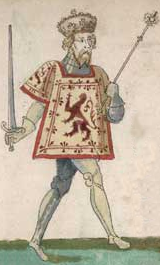
Robert Stewart, King Robert II of Scots
Stirling Castle
Rebuilt by King Robert II after it was destroyed during the Wars of Independance
c/o Historic Environment Scotland
The Great Seal of King Robert II (front and rear facing)
Crowned King Robert II of Scots
in 1371, King David II died without a male heir and on 26 March 1372, Robert Stewart was crowned King Robert II of Scots, the first of the Stewart dynasty of fifteen monarchs who would rule Scotland and later Great Britain until the Jacobite Risings of the 18th century.
King Robert II was well-prepared for ruling Scotland, having served as joint ruler for much of his adult life and having established a massive family power-base through his children. Early historians viewed him through the lens of the latter portion of his life and saw him as a weak ruler. Modern historians recognize that he had a long and successful rule for much of his reign until he weakened in his old age and his sons, whom he had invested with much power, began to flex their own powerful muscles — most especially his elder sons, John, Earl of Carrick (later King Robert III), Robert, Earl of Fife and Menteith (later Duke of Albany), and Alexander, Earl of Buchan, “The Wolf of Badenoch”.
Losing Power to his Sons
Robert’s son, Alexander Stewart, Earl of Buchan, was appointed Justiciar of the North and used his power to settle a personal vendetta with the Bishop of Moray. In June 1390, Alexander burned the cathedral and town of Elgin. Alexander’s brand of Highland justice was not well received throughout the rest of the country. King Robert II’s reluctance to rein in his rogue son undermined his authority. Critics claimed he was too feeble to rule. King Robert’s elder sons, John Stewart, Earl of Carrick, and Robert Stewart, Earl of Fife and Menteith, were amassing their own power bases and in 1388 had the Scottish High Counsel declare King Robert II unfit for rule. John, Earl of Carrick, with the assistance of Robert, Earl of Fife and Menteith, ruled Scotland in the name of their father until his death in 1390 as a recluse at Dundonald Castle where he had retired some time earlier.
Marriages and Children
King Robert II married firstly to Elizabeth Mure, of Rowallan, b. Abt 1320, Rowallan, Ayrshire, Scotland ![]() , d. 1353, Scotland,
, d. 1353, Scotland, ![]() daughter David Mure of Rowallan. They had the following children:
daughter David Mure of Rowallan. They had the following children:
1. Walter Stewart, Lord of Fife
Walter married to Isabella, Countess of Fife. She had inherited the earldom just a year before when her father died. Walter died before they had any children. Walter’s father, the king, convinced Isabella to surrender her earldom to Walter’s brother, Robert Stewart, Earl of Menteith.
2. John Stewart, Earl of Carrick, latterly King Robert III
In 1388, John Stewart, Earl of Carrick, and his younger brother, Robert Stewart, Earl of Fife and Menteith, persuaded the Scottish High Council that their father was too feeble to rule and had ruling authority vested in them for the remainder of their father’s reign. They dealt swiftly with their rogue brother, Alexander Stewart, “The Wolf of Badenoch”, stripping him of his title of Earl of Buchan and bestowing that title on Robert’s son, Murdoch Stewart.In 1390, King Robert II died and his eldest son, John, Earl of Carrick, was crowned King of Scots and took the reigning name of King Robert III. Robert III suffered from a prior injury rendering him partially disabled.
In the medieval world, a “lame” king was a weak king. King Robert III allowed his brother, Robert Stewart, Earl of Fife and Menteith, authority to run the affairs of state until 1393 when King Robert III reassumed his royal responsibilities for the next six years. Robert III then delegated his authority to his eldest son David Stewart, who, in 1398, was created Duke of Rothesay, the first royal Dukedom in Scotland. The king’s brother, Robert, Earl of Fife and Menteith, was likewise created Duke of Albany. Historians claim this was the beginning of a power struggle between the two Dukes as to who would rule Scotland.
King Robert III had the following children:
- Prince David Stewart, Duke of Rothesay. In 1401, David had proven to be so incompetent a ruler that his father, King Robert III, had him arrested and placed in the custody of his brother, Robert, Duke of Albany. While in custody, David died.Robert, Duke of Albany, was widely suspected to be responsible for Prince David’s death, An inquiry by the Scottish Council exonerated Robert. History, however, has never exonerated him. Historians have long suggested that Robert Stewart, Duke of Albany, was likely responsible for starving his rival nephew to death, suggesting that he did so as it would bring Robert one step closer to the throne with only his second nephew, the child Prince James (the future King James I), remaining in the way. Others have suggested that it may have been a recognition that Robert, Duke of Albany, was simply a more competent ruler than David.
- Prince James Stewart, latterly King James I. As a child, he was sent away to France for his own safety and to keep him away from Robert Stewart of Albany. His ship was intercepted and he spent the next 18 years in English captivity. His uncle Robert Stewart, Duke of Albany, and Robert’s son, Murdoch Stewart, 2nd Duke of Albany, did nothing to free King James. Upon James eventual release he returned to Scotland and had almost the entire Albany-Stewart family executed.
3. Robert Stewart, Duke of Albany
Robert’s story is told in the next section below.
4. Alexander Stewart, Earl of Buchan, "The Wolf of Badenoch"
5. Elizabeth Stewart, Princess of Scots
6. Isabella Stewart, Countess of Douglas
7. Jean Stewart, Lady of Glamis
8. Catherine Stewart, Princess of Scots
9. Margaret Stewart, Lady of the Isles
10. Marjory Stewart, Countess of Moray
Robert Stewart married secondly to his first-cousin, Euphemia de Ross, daughter of Hugh de Ross, Earl of Ross, and Robert’s aunt, Matilda Bruce, daughter of Robert The Bruce. They had the following children:
-
- David Stewart, Earl of Strathearn
- Elizabeth Stewart, wife of David Crawford, Earl of Crawford
- Walter Stewart, Earl of Atholl. He was later executed for his role in the gruesome murder of his nephew, King James I.
- Egidia Stewart, wife of William Douglas, Lord of Nithsdale
Robert Stewart had the following illegitimate children by several mistresses:
-
- John “The Red” Stewart, Sheriff of Bute. He was killed by his grand-nephew, James Mhor Stewart of Albany, grandson of Robert Stewart, Duke of Albany, when James burned the town of Dumbarton to the ground.
- Alexander Stewart of Inverlunan
- James Stewart of Abernethy and Kinfauns
- John Stewart of Arntully and Cardeny
- John Stewart, Lord of Burley
- Alexander Stewart, Canon of Glasgow
- Thomas Stewart, Archdeacon of St. Andrews and Dean of Dunkeld
- Walter Stewart, Rector of Tannadice
- John Stewart of Dundonald
- (other daughters whose names were not recorded)
Robert Stewart, Duke of Albany, Earl of Menteith, Earl of Fife, Earl of Atholl, Earl of Buchan, and Regent of Scotland
Robert Stewart, Duke of Albany, Earl of Menteith. Earl of Fife. Earl of Atholl. Earl of Buchan, b. Abt 1340, Dundonald, Ayrshire, Scotland ![]() , d. 3 Sep 1420, Stirling Castle, Stirlingshire, Scotland.
, d. 3 Sep 1420, Stirling Castle, Stirlingshire, Scotland. ![]() He is shown above as the third son of Robert Stewart, King Robert II of Scots.
He is shown above as the third son of Robert Stewart, King Robert II of Scots.
Robert Stewart, Duke of Albany, has traditionally been described as a man of ruthless ambition, however recent historian, Dr. Shayna Devlin, PhD, who acknowledges Robert’s ambitiousness, casts him in a more favourable light as a participant in a system of late medieval corporate (family) governance, where he was doing his part to participate in shared roles with his royal family members, albeit ambitiously.
(There are three Robert Stewarts in this family, making for a confusing read and necessitating the constant repetition of titles in order to distinguish which Robert is being referring to each time.)
(This) Robert Stewart was the third son of King Robert II of Scots, a man who persistently consolidated power in his very large family and vested much of that power in his eldest sons. This strategy was very successful until such time as his powerful sons began to flex their own influential muscles.
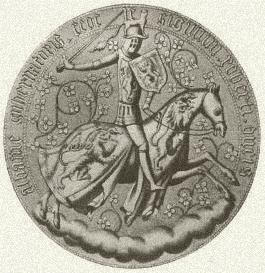
The Seal of Robert Stewart, Duke of Albany
Gaining the Earldom of Menteith
(This) Robert Stewart married in 1361 to Margaret Graham, Countess of Menteith, who, only a year prior, had inherited the Earldom of Menteith from her late father Sir John Graham, Earl of Menteith, through her mother, Mary, the late Countess of Menteith. Thus, Robert became Earl of Menteith and acquired lands around the town of Doune in southern Perthshire. Sometime shortly thereafter, Robert began restoration work on the 13th century ruins of Doune Castle to be his new residence.
Gaining the Earldom of Fife
Robert Stewart, Earl of Menteith’s eldest brother, Walter Stewart, had married Isabella, Countess of FIfe, bestowing the honour of Lord of Fife on Walter. Walter died in 1362 without any children. The king sought to keep the powerful Earldom of Fife in the family and convinced Isabella to resign her earldom to her brother-in-law, Robert Stewart, Earl of Menteith, in exchange for keeping the income for much of her lands, which she did in March 1371, after which Robert was styled Earl of Fife and Menteith.
Robert Stewart, Earl of Fife and Menteith’s younger brother, Alexander Stewart, was made Earl of Buchan and Justiciar of the North and abused his power there, eventually burning the town of Elgin in a dispute with the local bishop and earning Alexander the nickname “The Wolf of Badenoch”. Alexander’s abuse of power was destabilizing for the Stewart family grip on power throughout Scotland, and King Robert II was reluctant to rein in his rogue son.
After the death of his first wife, Robert Stewart, Earl of Fife and Menteith, married secondly to Muriella Keith, daughter of William Keith, Marischal of Scotland.
Governor of Scotland
In 1388, Robert II’s sons, John Stewart, Earl of Carrick, and Robert Stewart, Earl of Fife and Menteith, persuaded the Scottish High Council that their father was too feeble to rule and had ruling authority vested in them for the remainder of their father’s reign. They dealt swiftly with their rogue brother, Alexander, stripping him of his title of Earl of Buchan and bestowing that on Robert’s son, Murdoch Stewart.
In 1390, King Robert II died and his eldest son, John, Earl of Carrick, was crowned King of Scots and took the reigning name of King Robert III. Robert III suffered from a prior injury rendering him partially disabled. In the medieval world, a “lame” king was a weak king. King Robert III allowed his brother, Robert Stewart, Earl of Fife and Menteith, to run the affairs of state until 1393 when King Robert III resumed his royal responsibilities for the next six years. Robert III then delegated his authority to his eldest son David.
The Death of David Stewart, Duke of Rothesay
In 1398, the king’s son, David, was created Duke of Rothesay, the first royal Dukedom in Scotland. The king’s brother, Robert, Earl of Fife and Menteith, was likewise created Duke of Albany. Historians claim this was the beginning of a power struggle between the two Dukes as to who would rule Scotland.
In 1401 David had proved to be so incompetent that Robert III had him arrested and placed in the custody of his brother, Robert, Duke of Albany. While in custody, David died. Robert, Duke of Albany, was widely suspected to be responsible, however an inquiry by the Scottish Council exonerated him. History, however, has never exonerated him. Historians have long suggested that Robert Stewart, Duke of Albany, was likely responsible for starving his rival to death, suggesting that he did so as it would bring Robert one step closer to the throne with only his second nephew, James (the future King James I), remaining in the way. Others have suggested that it may have been a recognition that Robert, Duke of Albany, was simply a more competent ruler than David.
In 1402, under persuasion from the king, Robert’s stepmother, Euphemia, Countess of Ross, resigned her earldom of Ross in favour of Robert Stewart, Earl of Fife and Menteith. He bestowed the Earldom on his third son, Robert.
In late 1405, the king began to fear for the life of his remaining son, Prince James. In February 1406, 11-year-old Prince James was sent to France for his safety. His ship was intercepted by English pirates and James was taken to London as a prisoner of King Henry IV of England. A few weeks later in April 1406, Robert III died and the captive James became the uncrowned King James I of Scots. James remained a prisoner in the Tower of London for 18 years.
In the absence of the king, Robert Stewart, Duke of Albany, ruled Scotland as Regent and made little effort to secure the release of his nephew, the king.
Even though Robert Stewart, Duke of Albany, was never king, he governed Scotland at various times for over thirty years during the reigns of three kings. Robert had his second son, John Stewart, made Earl of Buchan, following the death of Robert’s brother, Alexander, The Wolf of Badenoch. Robert had his third son, Robert Stewart, made Earl of Ross, which angered Donald McDonald, Lord of the Isles, who felt the Earldom of Ross belonged to him, sparking an invasion by the Islesmen.
Upon the death of Robert Stewart, the Dukedom of Albany, the governorship of Scotland, Doune Castle, and all of Robert’s other titles and lands, passed to his eldest son, Murdoch Stewart. Murdoch continued to rule Scotland on behalf of the Albany Stewarts, but not for very long.
Marriages and Children
Robert Stewart, Duke of Albany, married firstly to Margaret Graham, Countess of Menteith, b. 1334, Perthshire, Scotland ![]() , d. 1380, Perthshire, Scotland,
, d. 1380, Perthshire, Scotland, ![]() daughter of John Graham, Earl of Menteith. They had the following children:
daughter of John Graham, Earl of Menteith. They had the following children:
- Murdoch Stewart, 2nd Duke of Albany. His story continues below.
- Janet Stewart
- Mary Stewart, who married William Abernethy of Saltoun.
- Margaret Stewart, who married John de Swinton
- Johanna Stewart, who married Robert Stewart of Innermeath (ancestor of the Stewarts of Appin)
- Beatrice Stewart, married James Douglas
- Isabella Stewart, married Alexander Leslie, Earl of Ross
Robert Stewart married secondly Muriella Keith. They had the following children:
- John Stewart, 2nd Earl of Buchan
- Andrew Stewart. He is believed to have died young.
- Robert Stewart, Earl of Ross
- Marjory Stewart, married Duncan Campbell of Lochawe, 1st Lord Campbell
- Elizabeth Stewart, married Malcolm Flemming of Biggar and Cumbernauld
Doune Castle
Doune Castle was the primary residence of the Dukes of Albany. Doune Castle was initially built in the 13th century by an unknown owner. The castle was damaged during the Wars of Independence. In 1361, Robert Stewart married to Margaret Graham, Countess of Menteith, daughter of the late Sir John Graham, Earl of Menteith. Graham territory included lands around Doune. Thus, Robert Stewart became Earl of Menteith and acquired lands including Doune in southern Perthshire. Sometime shortly thereafter, Robert began restoration work on Doune Castle. Robert’s son, Murdoch Stewart, 2nd Duke of Albany, later inherited Doune Castle. After Murdoch’s execution the castle became a royal residence.
In Film
Doune Castle has been a filming location for many famous works, including Monty Python and the Holy Grail, Game of Thrones, and Outlander.
A children’s view of life at Doune Castle in the days of Robert Stewart, Duke of Albany.
c/o Historic Environment Scotland
Murdoch Stewart, 2nd Duke of Albany, Earl of Menteith, Regent of Scotland
Sir Murdoch Stewart, 2nd Duke of Albany, Earl of Menteith, and Regent of Scotland, b. 1362, Dunreath, Strathblane, Argyllshire, Scotland ![]() , d. 25 May 1425, Stirling, Stirlingshire, Scotland.
, d. 25 May 1425, Stirling, Stirlingshire, Scotland. ![]() He is shown above as the only son of Robert Stewart, Duke of Albany, from his first marriage to Margaret Graham, Countess of Menteith. Murdoch had six sisters as well as three half-brother and two half-sisters from his father’s second marriage.
He is shown above as the only son of Robert Stewart, Duke of Albany, from his first marriage to Margaret Graham, Countess of Menteith. Murdoch had six sisters as well as three half-brother and two half-sisters from his father’s second marriage.
In 1389, Murdoch was appointed Justiciar of the North after the title was stripped from his rogue uncle, Alexander Stewart, Earl of Buchan, known as The Wolf of Badenoch. Murdoch worked with his father to consolidate power in the Albany Stewart family.
It was about this time that Murdoch married a woman named Joan who did not live long. They had no children. Her surname is unknown. She is only identified in the dispensation for the later marriage between Murdoch and Isobel of Lennox, in which Joan is described as being in the fourth degree of consanguinity (2nd cousins).
Marriage to Isabella, Countess of Lennox
In 1392, after an arrangement by their fathers, Murdoch Stewart married Isobel, Countess of Lennox, the last of the ancient Scottish Mormaers. Isobel would become a central power figure in the dynastic clashes between the Albany Stewarts and the Royal Stewarts. Murdoch and Isobel had five children together, likely born at Doune Castle. Murdoch is sometimes referred to in early charters as “of Kincleven” so the children may have been born and raised there. (Devlin) Murdoch also had a castle on Loch Ard in Aberfoyle parish, Perthshire, not far from his father’s castle in Doune, which was used solely as a hunting lodge.
Captivity in England
Murdoch served in several Scottish military campaigns. In 1402, Murdoch was capture by the English at the battle of Homildon Hill. This battle was such a decisive defeat that William Shakespeare wrote about it in his play, Henry IV. Murdoch was held prisoner for 12 years.
In 1405, Murdoch’s father, Robert Stewart, Duke of Albany, had Murdoch’s cousin, David Stewart, Duke of Rothesay and first in line for the throne, imprisoned. David died in captivity under suspicious circumstances. Robert, Duke of Albany, was widely believed to be responsible, but was exonerated. This left only the young Prince James in line for the throne ahead of the Albany Stewarts.
In 1406, Murdoch’s cousin, Prince James, was captured by the English and joined Murdoch as a prisoner in London. Weeks later, the king died, making James now the uncrowned captive King James I of Scots.
Murdoch’s father, Robert Stewart, Duke of Albany, worked diligently to ransom Murdoch but expended little effort to ransom the king. Robert’s neglect of the king would lead to a deadly rift between the Albany Stewarts and their Royal cousins. As the imprisoned king had no heirs, this made Duke Robert and his son Murdoch first and second in line for the throne.
In 1416, Murdoch was freed in a prisoner exchange negotiated by his father Robert, while King James remained in captivity London.
In 1419, Murdoch’s eldest son, Robert, died, leaving his next son Walter as heir and third in line for the throne.
Duke of Albany and Governor of Scotland
In 1420, Murdoch’s father died and Murdoch inherited the Dukedom of Albany, the Earldoms of Fife and Menteith, and the Governorship of Scotland. Murdoch was now ruler of Scotland. He and his son Walter were now first and second-in-line for the throne. But Murdoch would not rule for long. Murdoch made no effort to free King James until forced to do so by the Scottish Council in 1423. During the negotiations, Murdoch’s son, Walter, argued against the release of King James, feeling that he, Walter, would make a better king. Walter also argued against making peace with England, which was a necessary condition of James’ release. The Albany Stewarts had been campaigning against England for years, and Walter saw it as a sign of weakness to end the fighting. Walter had already fallen out with his father, Murdoch, over his future inheritance of the Earldom of Lennox, and Walter was also at odds with his father over the release of King James.
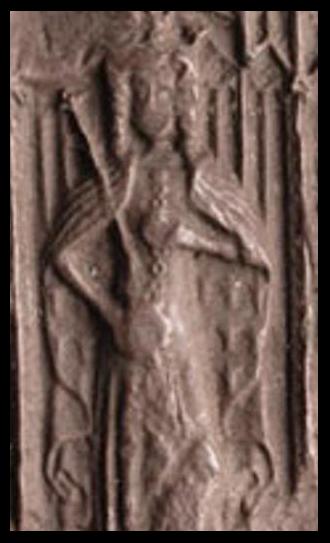
The Seal of Murdoch Stewart, 2nd Duke of Albany

The Release of King James I
On 28 March 1424, an agreement was reached for the release of King James I after having spent 18 of his 29 years in captivity. When James returned home, neither Murdoch nor Walter Stewart went to greet him at the border. Instead Murdoch sent his son Alexander and his father-in-law, Duncan of Lennox to represent the Albany Stewarts.
Part of the peace accord required hostages to be sent south. The Albany Stewarts ensured that none of their family members were included among the hostages, but, instead that many of the Black Douglases were. The Douglases were the next most powerful family in Scotland, This may have felt like a triumph for the Albany family, but it caused a rift with the Douglases.
King James Reduces the Albany Power
King James I knew that he had to move quickly and carefully to consolidate his own power and reduce or eliminate the threat of the Albany power. The Albany Stewarts had governed Scotland for nearly 40 years and had built a massive network of family loyalties. Many in the kingdom were far more loyal to the Albany Stewarts than to the king himself.
James first visited with his only surviving uncle, Walter Stewart, Earl of Atholl and bought him off. Then, on 13 May 1424, just a week before his coronation, King James had Murdoch’s son, Walter of Fife and Lennox, arrested along with two of his followers. Walter was imprisoned and held without charge or trial on the Bass Rock, Scotland’s least hospitable prison, where James himself had been held as a child. Scotland held its breath to see how Murdoch would react to the arrest and imprisonment of his son. Murdoch did not react and may have felt that Walter was more of a hindrance than a help to the family power.
It has long between the traditional right of the Earl of Fife to place the crown on the king’s head at the coronation ceremony. James invited Murdoch Stewart, Earl of Fife, to do so at his coronation on 21 May 1424, This gesture both appeared to honour Murdoch, but also forced Murdoch to acknowledge James as his lawful king, thus symbolically submitting the Albany power to James’ royal power. Murdoch relinquished the governorship of Scotland of Scotland in favour of the king.
King James I could not move too quickly against the Albany family, as Murdoch still had the loyalty of the Scots army under the command of Murdoch’s half-brother, John Stewart, Earl of Buchan. They were fighting in France with Scotland’s ally, the Dauphin Charles of France. However, by the end of that summer, in August 1424 the Earls of Buchan and Douglas fell at the Battle of Verneuil and the Scots army was wiped out, including many Albany loyalists. This severely weakened Murdoch’s political position back home. Rather than have the Buchan lands return to the Albany family, James had them forfeited and returned to the crown.
King James began to systematically reduce the power of the Albany family by excluding them and their allies from the High Council and eliminating the flow of royal monies to Murdoch’s allies, including the elimination of the customs income from Aberdeen and Inverness from their mutual cousin, Alexander Stewart, Earl of Mar, son of the late Alexander Stewart, Earl of Buchan, the Wolf of Badenoch. Again, all eyes turned to Murdoch Stewart to see how he would react. He did not react. Maybe Murdoch was being cautious, but it sent a message to his allies that he did not have their backs and his power-base grew weaker. King James continued to fill his Council with those who had been alienated by the Albany Stewarts. James also exploited a rift between the Albany Stewarts and the Black Douglases to win the Douglases over to his side.
Arrests of the Albany Stewarts
King James then had Murdoch’s father-in-law, Duncan, Earl of Lennox, and another supporter, Sir Robert Graham arrested. Again, all eyes turned to Murdoch. Again, Murdoch did not lift a finger in opposition. Sir Robert Graham was so angered that he later became one of the assassins of King James.
In November 1424, James then moved to capture the Lennox capital castle at Dumbarton and placed his half-uncle, Sir John “The Red” Stewart, Sheriff of Bute (one of the many illegitimate sons of King Robert III), in charge.
On 12 March 1425, King James called his second parliament. It was here that Murdoch Stewart seems to have finally found his voice. He opposed the king on two of the king’s proposals which were defeated. James was angered.
King James now moved to finish off the Albany family. On 21 March 1425, he had Murdoch Stewart, Duke of Albany, his son, Alexander, and his wife, Isobel of Lennox, all arrested. He had the Albany castles of Doune and Falkland seized. Murdoch’s son Walter was already in prison. His remaining son, James Mhor Stewart, escaped capture and fled deep into his mother’s lands in the Lennox to raise a rebel army from among the fomenting Lennox supporters. The rebels, under James Mhor Stewart of Albany burned the town of Dumbarton to the ground and killed the castle’s keeper, Sir John “The Red” Stewart, Sheriff of Bute. James Mohr Stewart’s rebellion failed and he fled to Ireland.
Execution of the Albany Stewarts
Murdoch along with his imprisoned sons and his father-in-law were charged with treason, tried, convicted, stripped of all lands and titles, and on 24 March 1425 they were executed by beheading at Stirling Castle. The earldoms of Fife, Menteith and Lennox were forfeited to the crown. Isabella of Lennox was imprisoned in Tantallon Castle for life. The Albany Stewarts were done.
Almost.
Isobel of Lennox and her son, James Mhor Stewart of Albany were still alive and they weren’t done.
Children
Murdoch Stewart, Duke of Albany, and Isabella, Countess of Lennox, had the following children:
1. Robert Stewart, Master of Fife, b. Abt 1393, Doune, Kilmadock, Perthshire, Scotland, d. 1419 (Age ~ 26 years)
Robert Stewart, Master of Fife, b. Abt 1393, Doune, Kilmadock, Perthshire, Scotland  , d. 1419 (Age ~ 26 years)
, d. 1419 (Age ~ 26 years)
Murdoch Stewart and Isobel of Lennox were married in 1392 and he was captured in 1402. In these ten years they had five children making the estimated birth date shown here reasonably accurate.
Robert’s father, Murdoch Stewart, was imprisoned in England from 1402-1416. During this time Robert represented his father’s interests at the court of his grandfather, Robert Stewart, Duke of Albany.
Robert’s death date is uncertain. Robert was due to marry his cousin Euphemia Stewart, only child of David Stewart, Earl of Strathearn. The dispensation for this marriage was given in 1414. Robert died and his younger brother Walter was then betrothed to Euphemia in 1415, making the date for Robert’s death likely sometime between the two dispensations. However, Devlin cites his death date as 1419 and indicates that he was listed as witness to several charters by his grandfather, Robert Stewart, Duke of Albany until 1419.
Robert died without issue.
2. Sir Walter Stewart, of Fife, b. Abt 1395, Doune, Kilmadock, Perthshire, Scotland, d. 24 May 1425, Stirling Castle, Stirlingshire, Scotland (Age ~ 30 years)
Sir Walter Stewart, of Fife, b. Abt 1395, Doune, Kilmadock, Perthshire, Scotland  , d. 24 May 1425, Stirling Castle, Stirlingshire, Scotland
, d. 24 May 1425, Stirling Castle, Stirlingshire, Scotland  (Age ~ 30 years)
(Age ~ 30 years)
After the death of his elder brother, Robert, in 1419, Walter became the eldest surviving son of the Albany family. As heir apparent to his father, Murdoch, Duke of Albany, this made Walter third in line for the throne — a position he clearly desired for himself. In the negotiations of 1423, leading up to the release of Walter’s cousin, King James I, Walter argued against the release and the peace treaty with England that would accompany it.
Shortly after James’ return to Scotland, Walter and a couple of his loyal followers were arrested by the King.
Walter was executed with his father and brother Alexander in 1425. See notes for father. Prior to his execution, Walter continue the family tradition of fathering a lot of babies.
Walter Stewart never married but had relations firstly with an unknown Campbell. They had the following illegitimate children:
- Sir Murdoch Stewart. He was one of the young orphans who fled to Ireland with his uncle, James Mhor Stewart of Albany.
- Arthur Stewart. He was one of the young orphans who fled to Ireland with his uncle, James Mhor Stewart of Albany.
- Sir Andrew Stewart, 1st Lord Avandale and Lord High Chancelor, b. 1425, Scotland, d. 1488, Scotland (Age 63 years) He was one of the young orphans who fled to Ireland with his uncle, James Mhor Stewart of Albany.Andrew returned from Ireland at the behest of his grandmother, Isobel, Countess of Lennox. He came into favour with the King and was created Lord Avandale in 1459. After the death of James II, Andrew was appointed Lord High Chancellor. He obtained letters of legitimation for his brothers. He is recorded as dying without progeny. Modern readers should be reminded that this means without MALE children; he did have a daughter.He was several times an Ambassador and in reward for his long and faithfull services to the Crown he had a grant of the Earldom of Lennox for his lifetime on 4 May 1471. He obtained legitimations for himself and his brothers Arthur and Walter, which passed the Great Seal on 17 April 1479 and resigned his Lordship of Avandale into the King’s hands for new infeftment with remainder to himself and the heirs male of his own body, whom failing, to his brothers Arthur and Walter and their heirs male respectively and seriatim. on 2 September 1479. (MacGregor)
Walter had relations secondly with Janet Erskine, daughter of Robert Erskine of that Ilk. They had one known illegitimate child:
- Walter Stewart, 1st of Morphie, b. Abt 1418, Scotland, d. Aft 1482, Scotland (Age ~ 65 years). From Walter descends the later Stewarts of Morphie, Methven, Beith, and the Lords Ochiltree, as well as the 16th century James Stewart, Lord Doune, whose lands included Glenfinglas. He was involved in the settling of Balquhidder Stewarts in Glenfinglas. (This link goes to our old website as we do not have the Glenfinglas page migrated to this website yet.)
Walter had the following illegitimate children by unknown women:
- Robert Stewart
- Alexander Stewart
- John Stewart of Johnston
- Marion Stewart
3. Sir Alexander Stewart, of Kinclevin, b. Abt 1397, Doune, Kilmadock, Perthshire, Scotland, d. 25 May 1425, Stirling Castle, Stirlingshire, Scotland (Age ~ 28 years)
Sir Alexander Stewart, of Kinclevin, b. Abt 1397, Doune, Kilmadock, Perthshire, Scotland  , d. 25 May 1425, Stirling Castle, Stirlingshire, Scotland
, d. 25 May 1425, Stirling Castle, Stirlingshire, Scotland  (Age ~ 28 years)
(Age ~ 28 years)
Murdoch Stewart and Isobel of Lennox were married in 1392 and he was captured in 1402. In these ten years they had five children making the estimated birth date shown here reasonably accurate.
Alexander was executed with his father and brother Walter in 1425. See notes for his father, Murdoch Stewart, 2nd Duke of Albany for information on the execution.
4. Sir James Mhor Stewart, of Albany, b. Abt 1399, Doune, Kilmadock, Perthshire, Scotland, d. 1429, Antrim, Ireland (Age ~ 30 years)
Sir James Mhor Stewart, of Albany, b. Abt 1399, Doune, Kilmadock, Perthshire, Scotland  , d. 1429, Antrim, Ireland
, d. 1429, Antrim, Ireland  (Age ~ 30 years)
(Age ~ 30 years)
James’ information is presented below.
5. Isabella Stewart, b. Abt 1401, Doune, Kilmadock, Perthshire, Scotland, d. UNKNOWN
Isabella Stewart, b. Abt 1401, Doune, Kilmadock, Perthshire, Scotland  , d. UNKNOWN
, d. UNKNOWN
Murdoch Stewart and Isobel of Lennox were married in 1392 and he was captured in 1402. In these ten years they had five children making the estimated birth date shown here reasonably accurate.
Isabella married Sir Walter Dhu Buchanan, 12th of Buchanan, b. Abt 1400, Lennox, Stirling, Scotland  , d. UNKNOWN. The Buchanan family remained allies to the later descendants of the Albany Stewarts.
, d. UNKNOWN. The Buchanan family remained allies to the later descendants of the Albany Stewarts.
Isabella and Walter had the following children:
-
- Sir Patrick Buchanan, 13th of Buchanan, b. Abt 1420, Lennox, Stirling, Scotland
 , d. UNKNOWN. He married Margaret Galbraith and had descendants.
, d. UNKNOWN. He married Margaret Galbraith and had descendants. - Thomas Buchanan, of Gartincaber, b. Abt 1422, Lennox, Stirling, Scotland
 , d. UNKNOWN
, d. UNKNOWN - Walter Buchanan, b. Abt 1424, Lennox, Stirling, Scotland
 , d. UNKNOWN
, d. UNKNOWN - Daughter Buchanan, b. Abt 1426, Lennox, Stirling, Scotland
 , d. UNKNOWN
, d. UNKNOWN
- Sir Patrick Buchanan, 13th of Buchanan, b. Abt 1420, Lennox, Stirling, Scotland
Andrew Fleming Hutchinson, in his book, The Lake of Menteith (1899), mistakenly shows her as the daughter of Sir James Mhor Stewart of Albany, rather than his sister.
Sir James Mhor Stewart of Albany
a.k.a. James “The Fat” Stewart
Sir James Mhor Stewart, of Albany, b. Abt 1399, Duke Murdoch’s Castle, Loch Ard, Aberfoyle, Perthshire, Scotland ![]() , d. 1429, Antrim, Ireland
, d. 1429, Antrim, Ireland ![]() was the fourth son of Murdoch Stewart and Isobel of Lennox. In Gaelic he was referred to as Seamus Mhor. He has been recorded in many places as James “The Gross” Stewart. We believe this nickname is an incorrect translation of his Gaelic nickname “Mhor”. “Mhor” means “big, large, or great.” We suspect that “Mhor” was at sometime rendered in Norman French, probably as “Le Gros,” which means “large”, but could easily be mistranslated into English as “The Gross”. James is also referred to as James “The Fat.” Thus we believe the correct translation of James Mhor Stewart should be “Big” James Stewart.
was the fourth son of Murdoch Stewart and Isobel of Lennox. In Gaelic he was referred to as Seamus Mhor. He has been recorded in many places as James “The Gross” Stewart. We believe this nickname is an incorrect translation of his Gaelic nickname “Mhor”. “Mhor” means “big, large, or great.” We suspect that “Mhor” was at sometime rendered in Norman French, probably as “Le Gros,” which means “large”, but could easily be mistranslated into English as “The Gross”. James is also referred to as James “The Fat.” Thus we believe the correct translation of James Mhor Stewart should be “Big” James Stewart.
Little is known of James’ early years. until 1424 when King James I was finally released from captivity in England and returned home. King James I had most of the Albany family arrested in August of 1424, including James Mhor Stewart’s father and mother, two brothers, and his maternal grandfather. James Mhor managed to escape capture and fled into his mother’s lands of the Lennox in western Stirlingshire where he attempted to raise an army in rebellion.
Failed Rebellion Against the King
James Mhor’s rebellion was put down by the King’s forces, but not before James Mhor burned the castle and town of Dumbarton killing the governor of the castle, his great-uncle, Sir John “The Red” Stewart, Sheriff of Bute. Unfortunately this action sealed the fate of James’ father and brothers and they were all executed on 24 May 1425. King James also had several captured supporters of James Mhor hanged, drawn and quartered with their quarters put on display in chains in what was left of the town of Dumbarton.
James Mhor Stewart retreated deeper into the Lennox lands around Loch Lomond, taking over Inchmurrin Castle, a Lennox stronghold. On 8 June 1425 the king’s forces under Lords Montgomery and Kilmaurs recaptured Inchmurrin. Again, James Mhor escaped. This time he fled to Antrim, Ireland, taking with him the infant illegitimate children of his late brother, Walter Stewart of Fife.
Exile in Ireland
“In 1426, Parliament passed an act principally concerning the western portion of Scotland towards Ireland in which ships going from Scotland to Ireland needed the king’s deputy’s permission. The reason for this [included] that a known rebel, James the Fat, was given shelter in Ireland likely with the MacDonalds of Antrim, relatives of the MacDonald Lords of the Isles, and contact with him may endanger the king.” (Devlin)
Devlin cites the Irish Annals of the Four Masters in an entry from 1429 recording James’s death which reads: “James Stuart, son of the king of Scotland [sic], and Roydomna of Scotland, who had been banished from Scotland to Ireland, died, after the arrival of a fleet from the men of Scotland to convey him home, that he might be made king.” Roydomna is a copying error for Roydamna which likely derives from the Irish Gaelic Ri-dama, which means “King’s relation” and was a term used to designate the heir to the throne. Devlin notes that in 1429 King James I still had no male heir, thus, with the execution of the rest of the Albany family, James Mhor really was first in line to the throne but for the fact that he’d been banished and stripped of the family’s lands and titles.
Lady MacDonald of Antrim
The Ardvorlich MSS indicate that James had relations with a “Lady McDonald.” The case for this mystery Lady MacDonald being the daughter of Eoin Mor Tanister MacDonald, Lord of the Glens of Antrim, is circumstantial, but persuasive. The Parliamentary decree (above) indicates that James was being sheltered by the McDonalds of Antrim. The Annals of the Four Masters (above) refers to James as a Prince of Scotland and next in line for the throne. Thus, he would only be paired with a daughter from the most powerful MacDonald family in Antrim, which would be the family of Eoin Mor Tanister MacDonald, younger brother of Donald MacDonald, 2nd Lord of the Isles. Eoin and Donald’s mother was Princess Margaret Stewart, sister of Robert Stewart, late Duke of Albany, making Eoin MacDonald and James Mhor Stewart first-cousins-once-removed, suggesting that James Mhor sought shelter with a close relative. Eoin had long been in rebellion against his brother Donald, Lord of the Isles. In 1411, Donald MacDonald, Lord of the Isles, attacked Robert Stewart, Duke of Albany, seeking claim to the Earldom of Ross. Eoin MacDonald of Antrim joined the army of Robert Stewart, Duke of Albany, against his brother, the Lord of the Isles. Thus, Eoin MacDonald of Antrim was already a committed ally of the Albany Stewarts and had fought alongside James Mhor Stewart’s grandfather. Some records indicate that Lady MacDonald came from the family of the Earls of Antrim, an office which was not created until 1603, but was bestowed upon a descendant of Eoin Mor Tanister MacDonald, making that an anachronistic reference to this same family.
James Mhor Stewart and Lady MacDonald had two children, James Beag Stewart and Matilda Stewart. (Weir mistakenly lists seven children, as she includes the illegitimate children of Walter Stewart of Fife who fled with James Mhor.)
As noted above, James Mhor Stewart died in 1429 just as a fleet was arriving to take him back to Scotland to challenge for the throne.
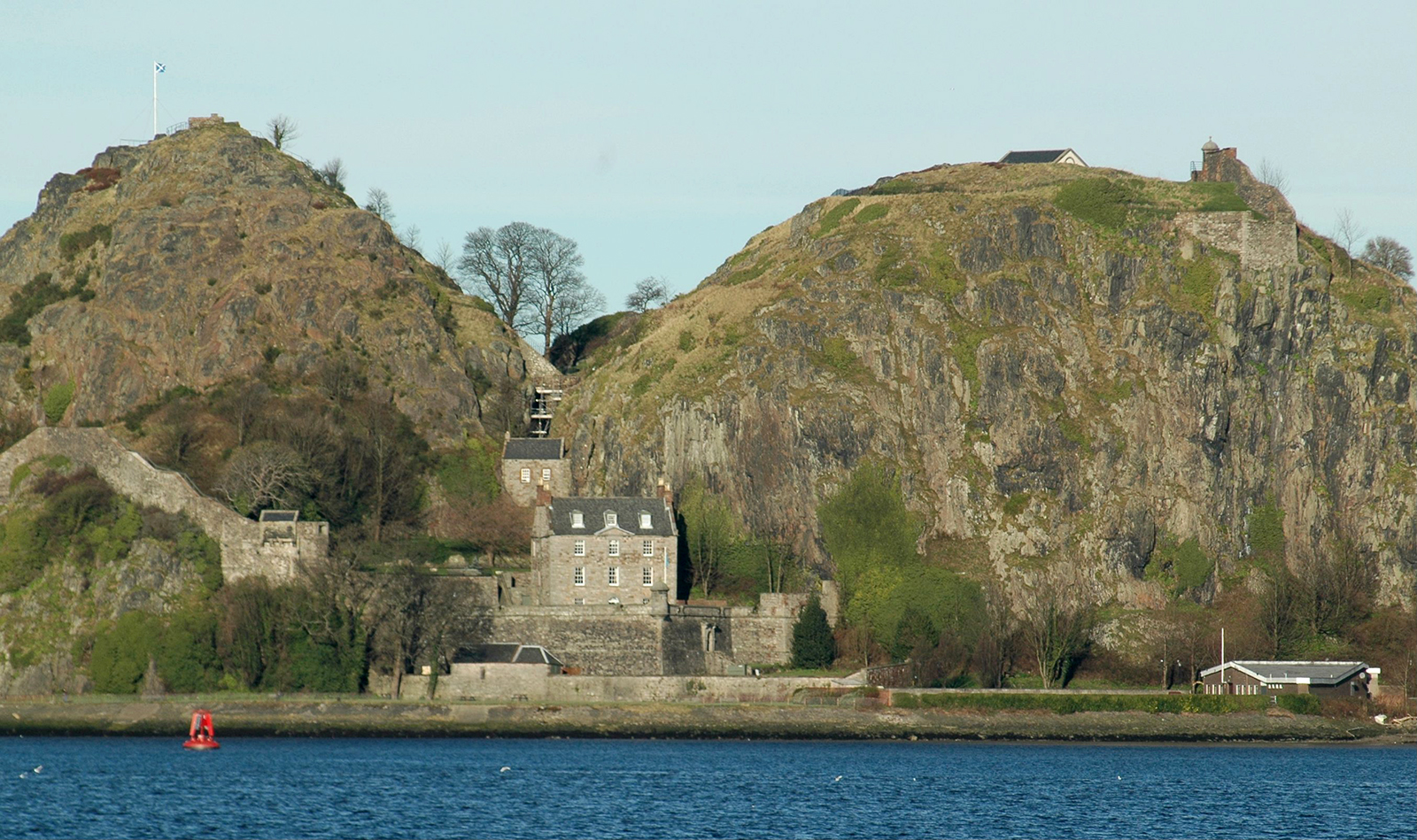
Dumbarton Castle – sacked and burned in 1424 by Sir James Mhor Stewart after the imprisonment of his family by King James I
(photo c/o Britannica.com)

Inchmurrin Island on Loch Lomand. Former site of Inchmurrin Castle, a stronghold of Duncan, Earl of Lennox, grandfather of James Mhor Stewart. James fled here after burning Dumbarton, and made a stand in 1426 where he was defeated and forced to flee to Antrim, Ireland.
Photo by Donald Thomas (Wikipedia)
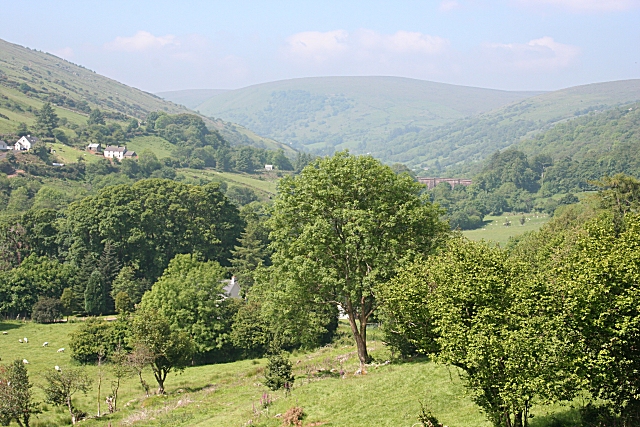
The Glens of Antrim
Photo by Anne Burgess (Wikipedia)
Children
Sir James Mhor Stewart and an unknown woman, believed to be the daughter of Eoin Mor Tanister MacDonald of the Glens of Antrim had the following children:
1. James Beag Stewart, of Albany and 1st of Baldorran and Balquhidder, b. Abt 1425, Antrim, Ireland, d. 1467, Scotland (Age ~ 42 years)
James Beag Stewart, of Albany and 1st of Baldorran and Royal Baillie of Balquhidder, b. Abt 1425, Antrim, Ireland  , d. Between 1464 and 1467, Scotland
, d. Between 1464 and 1467, Scotland  (Age ~ 39 years)
(Age ~ 39 years)
James Beag Stewart was one of only two children born in exile in Antrim, Ireland to James Mhor Stewart before he died. “Beag” means “little” in Gaelic and was presumably chosen to distinguish him from his father, James Mhor Stewart (“Mhor” means “big” or in James’ case, “fat.”) With the aid of his grandmother, Isobella, formerly Countess of Lennox, James was able to return home to Scotland where he acquired the properties of Baldorran and Balquhidder. His story continues on the Stewarts of Baldorran and Balquhidder page.
2. Matilda Stewart, b. Abt 1428, Antrim, Ireland, d. UNKNOWN
Matilda Stewart, b. Abt 1428, Antrim, Ireland  , d. UNKNOWN.
, d. UNKNOWN.
In 1445 Isabella also granted her granddaughter Mathilda, James’s sister, and her husband William Edmonstone of the lands of Duntreath in Lennox. It seems that even though neither child of James the Fat sought the rights to Lennox they still lived in the earldom close to their grandmother, and married into the local gentry. (Devlin)
Matilda married Alexander Stewart, 3rd of Grantully, b. 1444, Grandtully, Logierait, Perthshire, Scotland  , d. Abt 1488 (Age 44 years). They had the following children:
, d. Abt 1488 (Age 44 years). They had the following children:
-
- John Stewart, 4th of Grantully, b. Abt 1467, Grandtully, Logierait, Perthshire, Scotland
 , d. Abt 1490 (Age ~ 23 years). He had descendants.
, d. Abt 1490 (Age ~ 23 years). He had descendants. - Elizabeth Stewart, b. Abt 1470, Grandtully, Logierait, Perthshire, Scotland
 , d. UNKNOWN
, d. UNKNOWN
- John Stewart, 4th of Grantully, b. Abt 1467, Grandtully, Logierait, Perthshire, Scotland
Isabella of Lennox, Countess of Lennox, Duchess of Albany
Isobel of Lennox, Countess of Lennox, b. Abt 1368, Lennox, Dunbartonshire, Scotland ![]() , d. 1454, Inchmurrin Castle, Loch Lomand, Perthshire, Scotland,
, d. 1454, Inchmurrin Castle, Loch Lomand, Perthshire, Scotland, ![]() is a figure often overlooked by history. However a careful read of the story above will reveal that Isabella played a significant role in shaping the affairs of the Albany Stewarts.
is a figure often overlooked by history. However a careful read of the story above will reveal that Isabella played a significant role in shaping the affairs of the Albany Stewarts.
Isabella was the only child of Duncan of Lennox, Mormaer (Earl) of Lennox. Her father was a close ally of Robert Stewart, 1st Duke of Albany (above). Robert Stewart and Duncan of Lennox sealed their alliance with the marriage of their children. Isabella of Lennox married Murdoch Stewart, 2nd Duke of Albany (above). Their children are shown above.
Isabella would have grown up observing the power of the Albany family as they ruled Scotland for the entirety of her younger life. In 1425, King James I had Isabella and most of her family arrested, including Isabella’s father, Duncan of Lennox, her husband, Murdoch Stewart, 2nd Duke of Albany, and two of her sons Walter and Alexander Stewart. Her eldest son, Robert Stewart, had previously died. King James I had all the prisoners, except Isabella, executed. Isabella was imprisoned in Tantalon Castle ostensibly for the rest of her life. This left Isabella with only her son, James Mhor Stewart, daughter, Isabel Stewart, and the eight illegitimate grandchildren of her executed son, Walter Stewart.
In March 1437, King James I was murdered in a plot involving his uncle, Walter Stewart, Earl of Atholl, and carried out by several of Walter’s loyal servants who had previously been loyal servants of Isabella and her late husband, Murdoch Stewart. The death of King James I resulted in Isabella’s immediate freedom and restoration to the earldom of Lennox and her title Countess of Lennox.
On 12 May 1437, barely 8 weeks after the murder of King James I, Isabella, was already freed from captivity, and using her restored titles of Duchess of Albany and Countess of Lennox, and had already managed to secure the return of her 10 grandchildren from Ireland to Scotland.
Isabella outlived all her sons and all her enemies. She ruled the Lennox until her death in 1458.

